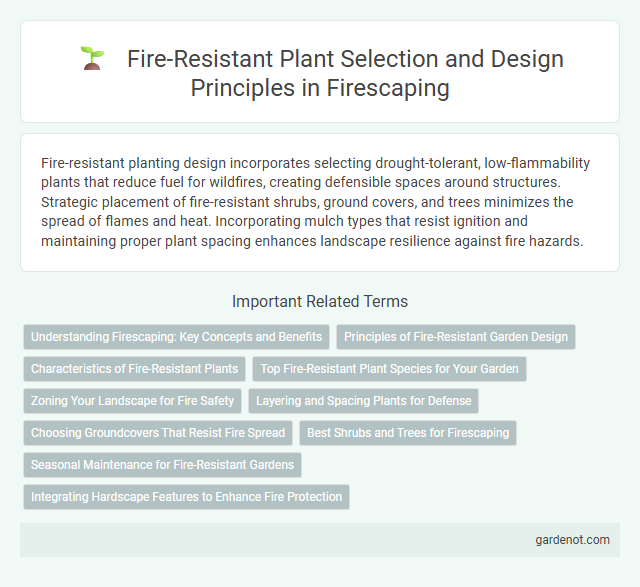Fire-resistant planting design incorporates selecting drought-tolerant, low-flammability plants that reduce fuel for wildfires, creating defensible spaces around structures. Strategic placement of fire-resistant shrubs, ground covers, and trees minimizes the spread of flames and heat. Incorporating mulch types that resist ignition and maintaining proper plant spacing enhances landscape resilience against fire hazards.
Understanding Firescaping: Key Concepts and Benefits
Fire-resistant planting design involves selecting and arranging vegetation to reduce wildfire risk by using plants with low flammability and maintaining adequate spacing to limit fire spread. Understanding firescaping principles helps create defensible spaces around properties, enhancing safety while preserving landscape aesthetics. Benefits include protection of structures, improved resilience of ecosystems, and decreased fuel load that mitigates wildfire intensity.
Principles of Fire-Resistant Garden Design
Fire-resistant garden design prioritizes selecting low-flammability plants with high moisture content, minimal resin, and low amounts of dead material to reduce fire risk. Strategic plant placement creates defensible space by incorporating fuel breaks, such as gravel paths and hardscape elements, to slow fire spread. Maintaining proper plant spacing, regular pruning, and removal of dead vegetation are key principles that enhance overall garden resilience against wildfires.
Characteristics of Fire-Resistant Plants
Fire-resistant plants typically possess high moisture content in their leaves and stems, which reduces their flammability during wildfires. These plants often have low resin, oil, and wax levels, minimizing the amount of combustible oils that can promote fire spread. Incorporating species with deep root systems and slow growth rates enhances resilience and aids in maintaining a defensible space around structures.
Top Fire-Resistant Plant Species for Your Garden
Top fire-resistant plant species for your garden include California lilac (Ceanothus), manzanita (Arctostaphylos), and aloe vera, known for their low flammability and high moisture content. These plants have thick, waxy, or fleshy leaves that reduce fire risk while providing aesthetic value and erosion control. Incorporating such species in firescaping enhances garden safety by slowing fire spread and protecting property.
Zoning Your Landscape for Fire Safety
Zoning your landscape for fire safety involves strategically arranging plants and hardscape materials to create defensible spaces that reduce fire risk. Establish distinct zones, such as a lean, clean, and green area closest to structures, which uses fire-resistant plants with low resin content and minimal dead material. Incorporate fire-resistant plants like succulents, lavender, and deciduous trees in the intermediate zone, while maintaining proper spacing and regularly removing flammable debris to slow fire spread.
Layering and Spacing Plants for Defense
Layering and spacing fire-resistant plants create multiple defensible zones that slow fire spread and reduce heat intensity near structures. Strategic placement of low, medium, and tall vegetation with adequate gaps limits fuel continuity and enhances accessibility for firefighting efforts. Proper layering combines drought-tolerant, fire-resistant species like succulents and native shrubs to form natural firebreaks while maintaining ecological health.
Choosing Groundcovers That Resist Fire Spread
Selecting fire-resistant groundcovers involves choosing species with high moisture content and low resin or oil levels, such as succulent ice plants, creeping sedum, and native ice plants. These groundcovers create a natural barrier that slows fire spread by producing minimal flammable material and maintaining a low-profile foliage structure. Proper spacing and regular maintenance enhance their effectiveness in reducing fire intensity and protecting surrounding landscapes.
Best Shrubs and Trees for Firescaping
Fire-resistant planting design centers on selecting shrubs and trees that naturally withstand high temperatures and reduce flame spread, such as manzanita, ceanothus, and California lilac. Trees like coast live oak, pistachio, and eucalyptus are favored for their ability to retain moisture and minimize combustible material. Incorporating these species strategically around properties enhances landscape resilience against wildfires while maintaining ecological balance.
Seasonal Maintenance for Fire-Resistant Gardens
Seasonal maintenance in fire-resistant planting design involves regular pruning of drought-tolerant, low-flammability species such as succulents, lavender, and rosemary to reduce dead material buildup. Removing dry leaves, thinning dense foliage, and maintaining appropriate spacing between plants enhance defensible space and minimize fire risk. Consistent monitoring during dry seasons ensures plants remain healthy and fire-resistant, supporting landscape resilience against wildfires.
Integrating Hardscape Features to Enhance Fire Protection
In fire-resistant planting design, incorporating hardscape features such as stone pathways, gravel beds, and non-combustible patios creates effective firebreaks that slow the spread of flames. These hardscape elements reduce the continuity of flammable vegetation, minimizing fire intensity near structures. Strategically positioning fire-resistant plants alongside hardscape barriers further enhances landscape resilience and promotes safer defensible space.
Fire-resistant planting design Infographic

 gardenot.com
gardenot.com